Carpet Scores Good Marks in Schools: A Smart, Sustainable Solution in Floor Coverings
Attractive, Cost-effective Products Create Learning-friendly Classrooms
![]() Continuing Education
Continuing Education
Use the following learning objectives to focus your study while reading this month’s Continuing Education article.
Learning Objectives - After reading this article, you will be able to:
- Discuss the benefits of carpets in schools.
- Specify the right carpet for high, medium and low traffic areas.
- Recommend a Carpet Maintenance Plan.
From kindergartners to postgraduate students, a pleasing school environment is a plus that can add up to superior performance. Over the past several decades, school design has been widely recognized as a factor in creating a good learning environment that strongly affects student achievement, social development and attendance, as well as teacher retention and satisfaction. In a 2001 study by the Atlanta-based research firm, Beth Schapiro & Associates, more than 92 percent of teachers surveyed believe general classroom design has a strong impact on students' learning and achievement. In the same study, teachers identified the top five design elements that promote the best learning environment: comfort, safety, lighting, temperature control and good acoustics.
Carpet helps achieve several of these design goals, and is a factor in the creation of welcoming, friendly and less institutional classrooms that can contribute to a better educational environment for students, teachers and school personnel. In fact, more than 70 percent of teachers surveyed in the Schapiro study prefer carpet on their classroom floor.
This article will cover the safety and health issues related to carpeting in schools, as well as guidelines to selecting the right carpet and keeping it a sustainable choice for the life of the product. The proper way to clean and maintain carpets will be explored, as well.
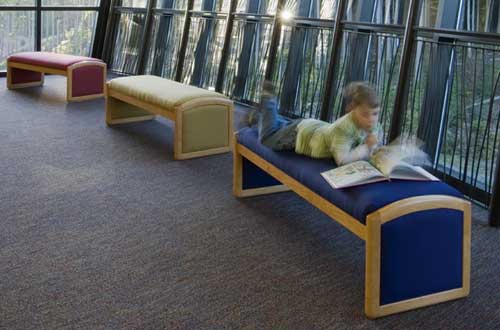 |
Photo courtesy of the Carpet and Rug Institute |
Benefits of Carpets
Carpet is a foundation for the look and feel of a room. It can provide a casual simplicity to reinforce a soft, livable ambiance or it can lend vibrancy to a room through strong colors and heavier textures. One of the easiest methods of personalizing an environment, carpet also offers a host of health and safety benefits.
Improved Safety. Because it affords more traction, carpet helps prevent falls. According to the above-mentioned Schapiro study, 77 percent of teachers agree that carpet helps prevent falls and injuries and makes a classroom safer. Not only do fewer slips and falls occur with carpeting, but when they do happen the chances of injury are greatly diminished on a soft floorcovering. Further, carpet provides a non-glare surface that reduces reflection and eyestrain.
Reduced Noise. With carpet, less acoustic protection is needed on the ceiling and elsewhere. This provides a better learning atmosphere with fewer distractions. According to the Technical Committee on Architectural Acoustics of the Acoustical Society of America, the speech intelligibility rating is 75 percent or even less in many classrooms, meaning that those with normal hearing can understand only 75 percent of the words read from a list. Research shows that background noise from inside and outside the classroom negatively affects learning. Excessive noise and reverberation interfere with speech audibility, leading to diminished understanding, learning and ability to focus on the lessons at hand. Flooring is a major component of comprehensive noise management. Based on a study by the American Society of Interior Designers, carpet is deemed to be 10 times more efficient in reducing noise compared to other flooring options. When a cushioned backing made with polyurethane technology is added, noise levels can be further reduced.
Increased Comfort. For teachers and other staff, a cushioned walking and standing surface reduces leg fatigue. Several studies have investigated the influence of floor surfaces on the body during long-term standing, and results show that softer floor materials usually result in less postural discomfort than standing on hard floor surfaces (Redfern & Cham, 2000). According to Rys and Konz (1988), heart rate was higher after two hours of standing on a concrete floor compared to carpet, and perceived comfort was higher when standing on carpet. Similarly, In 1997, Madeleine et al. found that after two hours of standing, the comfort level was greater for a soft surface. Standing on a hard surface increased parameters, such as shank swelling and muscle fatigue. It also detrimentally changed subjects' standing posture.
Better Insulation. Carpet is warmer to sit on or work on, extending the learning areas to space on the floor. Thermal comfort exists because carpet retains inside ambient temperatures for longer periods. Because of its fibrous construction, carpet traps a layer of air close to the floor. Air is an excellent thermal insulator and consequently carpet acts to increase the thermal insulation of a surface. Additionally, a pad beneath carpet can further increase this thermal insulation effect.
Research conducted at the Georgia Institute of Technology School of Textile Engineering tested the thermal insulation values (R-Values) of carpet and cushion and found that the total R-value was more dependent on the total thickness of the carpet than the type of fiber content. The research indicated that a carpet system comprising carpet and pad can increase the R-value of the floor to somewhere in the range of 2 to 4.
Lower Life-cycle Costs. Carpet that is properly selected, installed and maintained lasts up to 10 years or longer. When product, installation and maintenance supplies and labor costs are considered over a 15- to 20-year period, carpet showed lower life cycle costs than other flooring options. A 2002 report, "Life-cycle Cost Analysis for Floor Covering in School Facilities," prepared by the Institute of Inspection, Cleaning and Restoration Certification (IICRC), found that carpet could be 65 percent less expensive to maintain than hard surface flooring. In the study, buying and installing the hard surface flooring was less expensive than carpet. But when labor, supplies and equipment costs were calculated over a 22-year life cycle, carpet proved to be more cost effective. The life expectancy of the hard surface flooring was 22 years. The cost of replacing carpet after 11 years was factored into the analysis. The study also found that hard surface floors require two and onehalf times more cleaning than carpet and that hard surface cleaning supplies are about seven times more expensive than supplies for carpeted floors.
The carpet industry is working to make carpet even longer lasting in schools by creating more durable fibers and fabrication methods, improving primary and secondary backings and increasing the number of different design and performance options. Modular carpets, the fastest growing segment of the industry, provide the option of replacing parts of a carpeted surface, instead of the entire carpet.
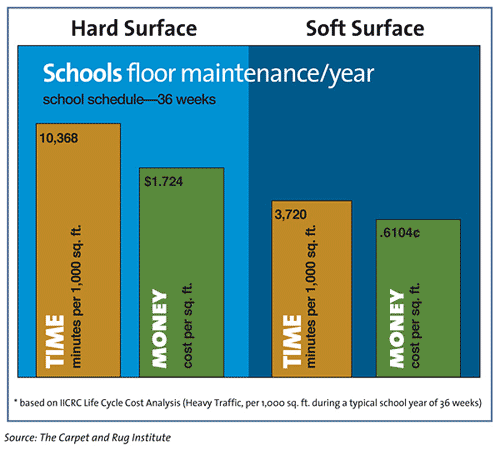
Improved Indoor Air Quality. Allergies are usually affected by airborne particles. Carpet traps allergens in its fiber and does not allow them to circulate in the air, even with the activity of children. The allergens trapped in the carpet then can be easily removed by adhering to a regular cleaning and maintenance schedule that includes vacuuming and periodic extraction cleaning using Seal of Approval-certified products. Studies have compared the distribution of airborne dust associated with normal activities on hard and soft flooring surfaces. In 2002, research by G. Asbury titled, "Cleaning and Foot Traffic Emissions Analysis," for the Professional Testing Laboratory, Inc., in Dalton, Georgia, showed that walking on hard surfaces disturbed more particles. These particles became airborne and entered the breathing zone. In contrast, carpeted surfaces trapped more particles so that walking disturbed fewer particles. The result was less dust in the breathing zone over carpeted floors.
In a government study in Sweden, when carpet was banned from public buildings and replaced with smooth surfaces, the allergic reactions of people actually increased as carpet use decreased. There were intensive discussions and reports in Sweden in the 1970s claiming that carpet was the source of harmful contaminants, resulting in allergic reactions. As a result, Swedish consumers and public building officials severely reduced their use of carpet. Carpet's share of the total floorcovering market in Sweden dropped from 40 percent in the mid-70s to only 2 percent in 1992. Based on historical figures published by the Swedish Statistical Central Bureau in the early nineties, Professors Roshan L. Shishoo and Alf B?sson, Swedish Institute of Fibre and Polymer Research, published an article for Carpet & Floorcovering Review, pointing out that while the use of carpet in Sweden had steadily decreased since 1975, the occurrences of allergic reactions in the general population had increased. Professors Shishoo and B?sson contend that the removal and decline of carpet usage did not mean improved conditions for allergic patients, who in fact missed the advantages of carpet such as comfort, insulation, and noise reduction.
Another indoor air quality issue is that of carpet and mold. Clean carpet does not support mold growth even at prolonged and elevated temperatures. However, left unresolved, leaks and spills, heavy condensation and localized flooding, especially when followed by prolonged high humidity, can lead to mold growth in many areas of a school. For mold to grow, it needs water, oxygen, a warm temperature and something that contains nutrients to feed on, such as dirt, wood or paper. Moisture trapped below a carpet can result in mold growth and the release of mold spores and mold metabolic products (microbial VOCs or MVOCs) into indoor air. Effective moisture control is critical to protect all building systems from the potential for mold growth. That said, studies have shown that the biggest source of mold spores is actually an improperly operated and maintained HVAC system. Shutting the HVAC system off at night or during downtime creates the perfect incubator for mold spores, which are then flushed into the breathing zone.
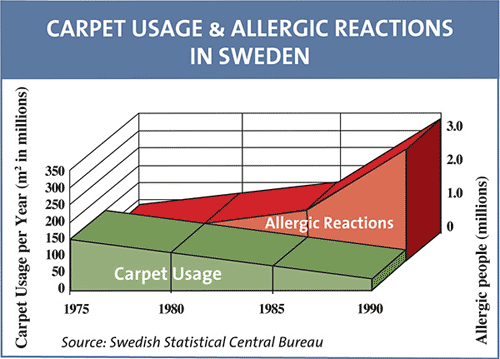
Indoor air quality also involves the emissions of volatile organic compound (VOC) levels from building materials. Carpet may be the lowest VOC emitter of common flooring choices and one of the lowest emitting products used in new construction and renovation, much lower than products such as paint. The already low VOC emission of new carpet drops significantly after 24 hours, even sooner with fresh air ventilation. According to Werner Braun of the Carpet and Rug Institute, the industry has developed a program known as the Indoor Air Quality Green Label Program to determine the level of VOC emissions from carpet, floor adhesives, and cushion products. Attached to a carpet, floor adhesive or cushion, the label signifies that a representative sample of the product type has been tested by an independent laboratory. The recent Green Label Plus is an enhancement that incorporates additional requirements to meet California's Collaborative for High Performance Schools (CHPS) low-emitting materials criteria. Products listed as CHPS-compliant materials have been chamber tested to meet the indoor air quality guidelines outlined in California's specification section 01350.
Selecting the Right Carpet
In many instances, new schools have incorporated a mix of floor coverings, with carpet in entrances and corridors to minimize dirt brought in and spread throughout the facility. Carpeting in these areas also provides extra traction for school children entering the building, particularly when it's wet or snowy outside. In elementary school classrooms carpeting is increasingly being used around teachers' and students' desks, with smooth surfaces reserved for around sinks and water fountains and in bathrooms and cafeterias.
Choosing the right carpet to stand up to the heavy traffic expected in a school is critical. Industry guidelines are geared to choosing an appropriate carpet for any area, from corridor to classroom to school office, classifying carpet's use according to expected traffic, determining the performance required for the location and for determining the carpet's desired physical characteristics. Compromising any specification recommendation can dramatically affect the way a carpet looks and its ease of cleaning.
Experience has taught that a low profile, densely tufted, tight loop construction is very functional in a school. Color selection is a prime factor in long-term appearance retention and facility managers and maintenance supervisors who understand this can increase the longevity of the carpet and save on future capital replacement. While a light color cut pile can make rooms and hallways look brighter, they are a poor choice in heavy traffic areas and can make successful maintenance more difficult. A darker color loop pile will retain its appearance longer and is a better choice in heavy traffic areas. Tweeds or patterns in the carpet are also a good choice as they add interest to the floor and hide soil.
"Carpet is a cost-effective way to bring color and texture into a project and has the flexibility to transition between areas within a school," says Lisa Pinyan, ASID, IIDA, LEED® AP, Director of Interior Design for Greenline Architecture in Savannah, Georgia.
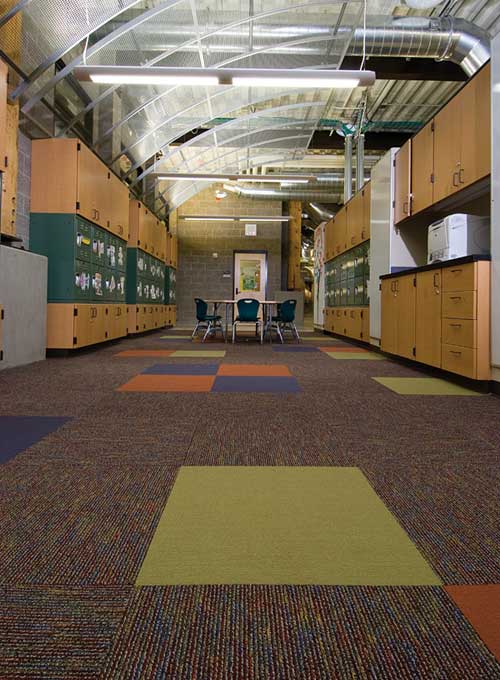 |
Variation in color and pattern can mask the effects of traffic in school settings. Photo courtesy of the Carpet and Rug Institute |
Pinyan favors some variation in color and pattern to mask the effects of traffic. "Darker colors and solid colors don't perform as well. They show the dirt and lint and all other debris," says Pinyan, noting that the construction method ? preferably loop ? and dye methods are two key factors in her specifying decisions. "When budgets allow, we go with solution-dyed carpets." Pinyan also notes that carpet tiles, the fastest growing component of the carpet industry, have their place. She specified them for Georgia Southern University's new College of Information Technology, where computer access flooring was used throughout much of the building. "They're more expensive initially, but they are easier to replace as individual carpet tiles become damaged. If the school has the budget for them, carpet tiles can have a longer life cycle," she says. Carpet tiles ranged from a modern pattern in common areas to those with color and warmth in the professional development area to classrooms where less pattern and stain hiding ability were considerations.
Carpet performance ratings, found on the carpet label, are a tool used by some manufacturers to help specifiers select the most appropriate carpet for various areas of a facility. Rated from 1 to 5, the scale represents the carpet's ability to withstand extended wear. A carpet with a higher performance rating such as 5 or 4 is one that will maintain its new appearance longer in various traffic conditions than one with a lower rating. A rating of 4.0 is considered outstanding. These carpets are recommended for a school's heavy traffic locations, which would include such areas as entrances, corridors, student break areas and classrooms. A rating of 3 or higher is predicted to provide normal durability and would be appropriate for libraries, conference rooms, media centers or classrooms with limited use. A rating of 2.5 or higher is predicted to be appropriate for teacher or administrative offices.
These ratings do not take into account soiling, poor maintenance or other factors of use; just the change of texture related to matting and crushing that might occur from walking on it. For these reasons, it is not practical to associate years of wear with the performance ratings. To obtain the projected appearance retention performance, the carpet must be correctly installed following the manufacturer's instructions and in accordance with industry installation guidelines and must be in accordance with the carpet manufacturer's recommendations.
The Texture Retention Rating value is determined by grading the appearance change of a carpet subjected to simulated traffic exposure either from actual walkers or from laboratory drum tests such as Hexapod or Vettermann Drum testers. Carpet is tested without underlay cushion material. After simulated traffic exposure, the exposure-conditioned carpet is rated according to an assessment of carpet surface change using industry grading scales.
Sustainability. With the plethora of carpet types available in the marketplace, selecting the most sustainable carpet can be a challenge. NSF 140-2007, certified by the American National Standards Institute (ANSI), is the prevailing standard for sustainable carpet. The standard is voluntary, based on life-cycle assessment principles, and provides a single rating system that recognizes levels of achievement ? mandatory minimum standards of sustainable performance as well as silver, gold and platinum levels that define a more sustainable carpet. It establishes performance requirements and quantifiable metrics throughout the supply chain for public health and environment; energy and energy efficiency; bio-based, recycled content materials; manufacturing; and reclamation and end of life management. While the standard can be used to evaluate any carpet product, it is primarily intended for commercial carpets as its evaluation methodology is complementary to emerging commercial green building standards.
Standards for Installation
Proper installation is critical to carpet performance. Specific installation instructions from manufacturers should be followed. A professional installer will understand these guidelines and know that carpet must be installed correctly to perform satisfactorily over time. Most school carpet is installed using the direct glue method of installation, whereby the carpet is adhered directly to the subfloor with an adhesive.
Carpet installed in accordance with the manufacturer's recommendation and with the industry standard will escape many common installation problems, such as the development of wrinkles and buckles, zippering, and seam failures. Adequate adhesive should be applied and seams secured with seam sealers to prevent the most common causes of installation complaints with school carpet.
Cleaning and Maintenance
Architects who can advise clients on product care and maintenance will help to increase the life cycle of the product. Pinyan says she has steered clients to professional carpet care. "School maintenance people tend to use topical treatments, which can be magnets for dirt," says Pinyan. "We favor hot water extraction cleaning, which can actually make a carpet look better over time."
When it comes to carpet, appearance depends not only on its color, pattern, density, fiber, but its maintenance program. Like many of today's consumer products, carpet can have a long life if properly cared for and maintained. Generally speaking, carpet can last from seven to 12 years. But when carpet wears out or "uglies out" well before its time, it not only results in a financial loss for the owner, but it doubles or triples the product's environmental footprint. For example, an educational facility that purchased 4,800 square yards of carpet at a cost of $67,200 found that the product uglied out in only two years due to poor cleaning and maintenance procedures. The loss in value to the facility: $56,000.
Carpets are more stain resistant than ever, making them easier to clean and maintain. However, maintaining the life and beauty of carpet depends on several factors: the quality of products and equipment used to clean carpets; the frequency and methods by which carpets are cleaned; and the skill and knowledge of the people doing the cleaning. It's important to note that there is a big difference between cleaning carpet and maintaining carpet.
Cleaning is the removal of apparent soil. For many commercial carpet owners, cleaning takes place irregularly, on an "as needed" basis. Soiling, however, is a cumulative process which, if allowed to go too far, cannot easily be reversed. Maintenance, in contrast to cleaning, is a scheduled on-going process of soil removal designed to maintain carpet's daily appearance at a consistent level of cleanliness. In caring for carpet, schools are advised to follow a regular maintenance program using cleaning products that meet rigorous standards.
While carpet cleaning products, methods and equipment are improving all the time, not all cleaning products clean equally well. Industry experts have tested an assortment of carpet cleaning solutions and equipment and found a wide variance in how well these products work, with some products even damaging carpet. The Seal of Approval (SOA) identifies effective carpet cleaning solutions and equipment in several categories, including spot removers, vacuums and extractors. An independent laboratory has tested off-the-shelf spot removers and pre-spray solutions. Of the 25 products tested, only four cleaned a soiled carpet sample better than water. Some caused the cleaned carpet area to resoil faster and some products damaged the carpet's color and texture. Spot removers are tested for their efficacy, as well as to show that they do not encourage resoiling or cause damage to the carpet. Further, vacuums must not affect the texture of the commercial cut pile carpet more than a onestep change based on one year of normal vacuum use. Extractors are tested to make sure they clean properly and they remove water from the carpet.
A customized comprehensive carpet care program consists of five elements:
1. Soil Containment. Soil containment is the isolation of soil entering the building using mats at entrances. Outside mats scrape debris off of shoes that have the capability to track in that material. Soil-removal mats that have a coarse texture are able to brush soil from shoes, and hold large amounts of soil in their pile. Inside mats remove smaller particles of dirt as well as oils and other liquids that can be tracked in from outside. Water-absorbent mats prevent tracked-in moisture from getting to the carpet. Mats that extend for 6 to 15 feet inside the entrance will trap eighty percent of soil and moisture from the first five or six steps. Another way to prevent soiling using mats is by placing protective mats around food stations, water coolers, elevators, and stair thresholds to prevent moisture and dirt from becoming ground into carpet.
2. Vacuuming. Vacuuming is the single most effective and economical means of keeping carpet in schools clean. The majority of dry soil can be removed from carpet by following scheduled, routine vacuuming procedures. Through independent testing, the industry can certify high-performance vacuums that are effective in removing soil and keeping dust and other particles within the canister so they do not circulate back into the air. Daily vacuuming is advised for carpeted areas with heavy foot traffic. Other areas should be vacuumed two or three times a week.
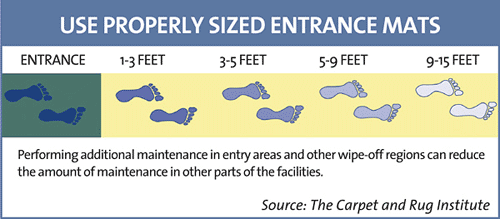
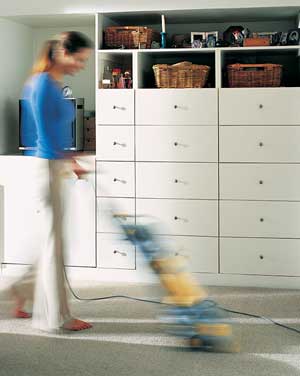 |
Vacuuming is an effective, economical way to keep carpets clean. Photo courtesy of the Carpet and Rug Institute |
3. Spot and Spill Removal System. In busy schools, floor coverings are subjected to spills on a daily basis. Prompt removal is recommended as the more time the spill remains on the carpet, the more difficult it will be to remove. Spills on carpets should be quickly addressed and always within 24 hours. A portable extractor will remove spots quickly and effectively.
4. Interim Cleaning. Twice a year carpet should undergo extraction cleaning by trained custodians or professional cleaning services. Suggested times are just prior to the school year and during winter holiday break.
5. Restorative Cleaning. Schools should schedule deep cleaning to remove residues and trapped soils.
There are some conditions where appearance change must be expected. In areas where the oily material from asphalt sealers is tracked into the building, carpet and other flooring may become yellowed over time. Carpeting that has experienced a slight dulling of color indicates a build up of soil. It is virtually impossible to remove all of this material once it has penetrated the fiber of any carpet. Entrance mats and scheduled cleaning can reduce this phenomenon. Areas where large amounts of sandy soil enter the building may become dull in appearance over time. This is due to abrasion of the fiber surface, affecting the reflection of light. Frequent vacuuming helps to minimize this problem.
Troubleshooting Common Carpet Issues
Texture Surface Retention. Carpet in heavily traveled areas receives the most wear. For better appearance and longer carpet life, try to reduce the amount of traffic on these areas or use small rugs in front of heavily used chairs or furniture. Remove and clean these rugs while vacuuming the primary carpet or rug. You should occasionally move furniture and reverse area rugs. Although some change will eventually occur in the texture of your carpet, reducing the wear on paths and in front of furniture will slow this change.
Crushing. Crushing is the loss of pile thickness because of foot traffic. Crushing is not considered a manufacturing defect unless it is specifically cited in the manufacturer's warranty. Regular vacuuming may help reduce crushing that results from traffic. Manufacturers' definitions of crushing may vary.
Depressions or Indentations. The weight of heavy pieces of furniture can cause indentations in carpet. Some depressions may be permanent. Use furniture glides or cups under the legs of heavy pieces, or move your furniture a few inches backward or sideways so that the weight is not concentrated in one place. To remedy depressions, work the carpet pile back into place with your fingertips or the edge of a spoon, then, dampen the area and heat it with a hair dryer, working the fibers with your fingers or a spoon.
Fading or Color Loss. Carpet should be given normal protection from direct sunlight. Emissions from heating systems or chemicals or cleaning agents can also result in color loss.
 Filtration Soil. Filtration soil may appear as dark or grayish
lines on carpet along walls, stairways and under doors. It is caused
by airflow over and through carpet, allowing fine soils to settle on
the surface. It is often caused by an improperly balanced ventilation
system, when the volume of air entering a room exceeds the
system's capacity to remove air from the room. Excess air then
seeks exit sources in gaps along walls and stairways. Prevent the
airflow through carpet and carpet edges by sealing openings through
the carpet and under doors and baseboards. Keeping the air in the
area clean and using good filtration in heating and cooling systems
and vacuum cleaners can help. Filtration soils may require special
cleaning treatment for effective removal.
Filtration Soil. Filtration soil may appear as dark or grayish
lines on carpet along walls, stairways and under doors. It is caused
by airflow over and through carpet, allowing fine soils to settle on
the surface. It is often caused by an improperly balanced ventilation
system, when the volume of air entering a room exceeds the
system's capacity to remove air from the room. Excess air then
seeks exit sources in gaps along walls and stairways. Prevent the
airflow through carpet and carpet edges by sealing openings through
the carpet and under doors and baseboards. Keeping the air in the
area clean and using good filtration in heating and cooling systems
and vacuum cleaners can help. Filtration soils may require special
cleaning treatment for effective removal.
Fluffing and Shedding. The balls of fluff, or loose fibers found on carpet are the normal result of fiber left in the carpet from the manufacturing process. Removing these loose fibers does not affect carpet life or appearance. Because of their large size, these fibers are too big to become airborne or to be breathed in. With proper vacuuming using a quality vacuum cleaner, most shedding gradually disappears within the first year after installation.
Matting. Manufacturers' definitions of matting may vary. Matting is usually the result of the untwisting of the yarn and the intermingling of the yarn tips through foot traffic. Matting may be caused by various factors, including an improperly specified cushion, cushion failure, or improper maintenance. Matting is not considered a manufacturing defect unless it is specifically cited in the manufacturer's warranty.
Moth, Beetle and Flea Control. Most wool and wool-blend carpet made in the United States is permanently treated to prevent moth damage. Carpet and rugs of manufactured (synthetic) fibers are naturally resistant to insects, because such fibers are not a food source and are resistant to beetles, commonly called carpet beetles.
Soiling. Dirty, airborne particles may be deposited on carpet, causing dulling. Dulling is caused by the deposits of all types of soil. A delicate rose color, for example, may dull down to a neutral taupe because of soil, while light blue may take on a dull, gray-green hue. Red clay soil also can cause a pronounced change in some colors. In spite of such phenomena, the original color of a carpet is not lost; it is still present under the soil. Oily soil may be very difficult to remove after it has been on the carpet for a long time, and it may be actually absorbed into the fiber, causing the carpet to have a yellow cast. Frequent cleanings are important to avoid this problem. Entry mats at doorways trap soil, and combined with routine cleaning and vacuuming, provide extra protection for all floor coverings.
Sprouting. Occasionally, a yarn tuft will rise above the pile surface of a carpet. Rather than pulling them out, these can be snipped off to the level of other tufts. If the problem persists in a localized area, the flooring contractor or manufacturer should be notified.
Topical Treatments. Topical treatments include soil retardants, stain repellents, antistatic treatments and deodorizers. The use of after-market, topical treatments without the express approval of the carpet manufacturer prior to application may void applicable warranties.
Wear. Most carpet manufacturers offer "wear" warranties of various time lengths. According to these warranties, "wear" is defined as the loss of pile weight or pile fiber (usually 10 percent) due to abrasive loss of fiber by weight. What appears to be wear, or pile fiber loss, may actually be matting, crushing or permanent fiber damage caused by soiling rather than loss of fiber. There is seldom actual loss of pile fiber.
Wrinkles, Ripples and Buckles. Wrinkles, ripples and buckles in carpet are most often caused by a failure to stretch the carpet correctly using a power stretcher, the use of an incorrect or failed cushion, or excessive temperature and/or humidity. Ripples can be caused by a combination of any of the above. If ripples or buckles develop, consult the carpet retailer. Generally, the problem can be corrected by a qualified carpet installer who reinstalls the carpet with a power stretcher.
Conclusion
In conclusion, carpet has a lot to offer in a school environment. Besides being a cost-effective way to add color and pattern, carpet offers advantages across a spectrum of safety and health concerns. And when properly cleaned and maintained, carpet is part of a winning aesthetic welcomed by students and teachers alike.
Â
|

